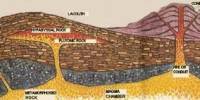Twice in Earth’s history, huge mountain ranges as towering as the Himalayas and stretching thousands of kilometers further rose their craggy heads out of the Earth, cutting old supercontinents in half. Geologists refer to them as “supermountains.”
According to a new study by experts at The Australian National University, giant mountain ranges at least as high as the Himalayas and reaching up to 8,000 kilometers over entire supercontinents played a critical role in the evolution of early life on Earth (ANU).
The researchers used remnants of zircon with low lutetium content to trace the construction of these supermountains throughout Earth’s history. This combination of minerals and rare earth elements is only found in the roots of high mountains, where they grow under extreme pressure. The loss of these ancient mountains may have sparked one of Earth’s most significant evolutionary booms.
The study discovered that the most massive of these supermountains formed only twice in Earth’s history, once between 2,000 and 1,800 million years ago and again between 650 and 500 million years ago. Both mountain ranges arose during supercontinent building eras. According to the lead author, ANU Ph.D. candidate Ziyi Zhu, there are ties between these two examples of supermountains and the two most crucial periods of Earth’s evolution.
What’s amazing is how clear the record of mountain formation over time is. It depicts two massive spikes, one associated with the advent of animals and the other with the emergence of complicated large cells.
Professor Jochen Brocks
“Nothing compares to these two supermountains today. It’s not simply their height; image the 2,400-kilometer-long Himalayas multiplied three or four times to get a sense of magnitude” She stated.
“The first example is known as the Nuna Supermountain. It corresponds with the most likely appearance of eukaryotes, the organisms that gave rise to plants and animals. The second, known as the Transgondwanan Supermountain, corresponds with the advent of the first giant animals 575 million years ago and the Cambrian explosion 45 million years later, when the majority of animal groups first emerged in the fossil record.”
Professor Jochen Brocks, a co-author, stated: “What’s amazing is how clear the record of mountain formation over time is. It depicts two massive spikes, one associated with the advent of animals and the other with the emergence of complicated large cells.”
When the mountains eroded, they released vital nutrients into the waters such as phosphorus and iron, supercharging biological cycles and driving the evolution to greater complexity. The supermountains may also have increased the amount of oxygen in the atmosphere, which is required for sophisticated life to breathe.

“The early Earth’s atmosphere had essentially no oxygen in it. The increase in atmospheric oxygen levels is likely to have occurred in a number of steps, two of which correlate with the supermountains” Ms. Zhu stated.
“The increase in atmospheric oxygen linked with the erosion of the Transgondwanan Supermountain is the largest in Earth’s history, and it was required for the advent of animals.” There is no evidence of any additional supermountains emerging between these two periods, which makes them even more remarkable.
“The period between 1,800 and 800 million years ago is known as the Boring Billion because there was little or no evolutionary progress,” co-author Professor Ian Campbell explained. “The absence of supermountains during that time period is thought to have slowed evolution by decreasing the delivery of nutrients to the oceans. This discovery provides markers that will help us better comprehend the evolution of early, sophisticated life.”
Evolution in overdrive
According to the researchers, as both mountains eroded, they would have discharged massive amounts of nutrients such as iron and phosphorus into the sea via the water cycle. These nutrients may have accelerated biological cycles in the water, causing evolution to become more complicated. In addition to nutrient spillage, disintegrating mountains may have released oxygen into the atmosphere, making Earth even more favorable to complex life.
The development of the Nuna Supermountain, for example, coincides with the advent of Earth’s first eukaryotic cells — cells with a nucleus that subsequently evolved into plants, animals, and fungi. Meanwhile, the Transgondwanan Supermountain would have eroded while another evolutionary boom occurred in Earth’s seas.
“The Transgondwanan Supermountain corresponds with the appearance of the first giant animals 575 million years ago and the Cambrian explosion 45 million years later when most animal groups appeared in the fossil record,” Zhu explained.
The academics were able to pinpoint the origin of the supercordilleras by evaluating samples of zircon with a low proportion of lutetium, a mineral considered a rare-earth that is only found near the base of high mountains, where it forms under severe pressure over millions of years.
















